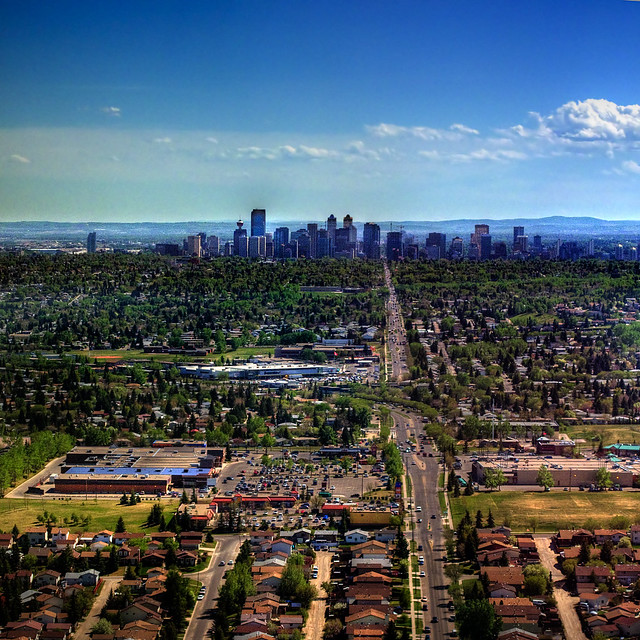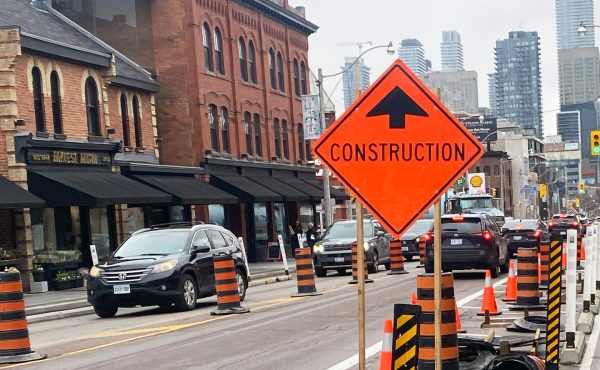
Photo by ecstaticist.
Western cities are built in this neat way where the downtown parts, middle parts (say, streetcar suburbs) and farther-out parts (what we might call “suburban” parts) are closer together, and often blended together. These are newer cities — newer than those in the east, and certainly those in Europe — so their tree-like “growth circles” are fewer and closer together. In a place like Calgary, these neighbourhoods surround the downtown core within close view of the cluster of skyscrapers, a proximity that seems subtly odd, but affords and interesting kind of urbanism.
South of downtown Calgary, the railway corridor cuts just below those skyscrapers — the same railway that stitches Canada together, making it seem a more formidable barrier than it is — beyond which is an old industrial warehouse district that has become, as these places often do, an entertainment and creative class district mixed with apartment buildings. Eleventh Avenue here used to be called Electric Avenue, lined with bars and clubs, but sometimes it had too much voltage so the city turned it a few notches down. Further south is 17th Avenue, a street of bars, restaurants and shops. It’s the kind of place where an inevitably spontaneous hockey celebration might happen, giving this strip the name Red Mile.
South of 17th is a remarkable swath of fairly dense residential housing that includes older homes and modernist (and newer) low-rise apartment buildings. Like Los Angeles, there is an unexpected and leafy kind of thick urbanity here, where a walk down a sidewalk could be beside an older home from the 1920s but abruptly switch to a postwar modern low-rise apartment building next door. The sidewalk experience is not at all boring, there are people nearby, sometimes one layer, sometimes more. Urbanity in western cities is subtle but when it works it’s kind of great, the buildings have more breathing room than those in the east. Once you get used to that, an appreciation of the place begins to grow.
In 2005, I was in Calgary for a week and became friendly with a Calgarian who whisked us in a minivan north across the Bow River to the Crescent Heights neigbourhood. Another nice mix of pre- and post-war residential homes, our destination was a party in a modernist bungalow. We’re taught to think these homes house nuclear families, but inside were some twenty-something professionals living communally, surrounded by expensive home entertainment electronics: a $20,000 video camera, the first domestic plasma TV I saw, and other toys for adults. Our host whispered in my ear “oil money,” which seemed to explain everything. Apart from this bit of Canadian economic culture I was seeing, the ability of modern homes to adapt to different modes of living, just as pre-war houses are used (think of rooming houses or student co-ops in Victorian or Edwardian homes) was something I hadn’t seen much of before.
As Robert M. Stamp writes in his fine book Suburban Modern: Postwar Dreams in Calgary the city embraced modernism late, well after WWII, but redefined it on their own terms and built residential architect accordingly:
They moved modernism out of the studios of the avant-garde producers and into the hands (and hearts) of the middle-class consumers, out of downtown art salons and design studios and onto the streets and into the suburbs…and redefined modernism to include modern homes in modern suburbs, with modern furniture and modern appliances and modern cars. For postwar Calgarians, modernism meant personal betterment, achieving all those material gains that had been delayed or denied by 15 years of depression and war.
So, like Montreal and Toronto, Calgary too is a great modernist Canadian city.
Shawn Micallef is a Senior Editor at Spacing Magazine and author of Stroll: Psychogeographic Walking Tours of Toronto




12 comments
When I lived in Phoenix – which has one walkable neighbourhood of 3 blocks in the entire metro area of 4 million – people were creatively using suburbia in the same way. Backyards became beer gardens; bungalows became cooperatives; people would turn garages into studios and paint there; progressive people biked around and would turn their front yards into secure bike parking. It’s not traditional urbanism, but it brings out the same kind of cultural qualities in the people who live there.
I miss it. Western cities are younger and freer. They’re trying to craft themselves into something new and exciting, so the people who run those places always have an attentive ear to change. They never had manufacturing industries that built the city and then died, so residents don’t have that Springsteenesque blue collar chip on their shoulder that leads locals to vote for reactionaries, worship the police as demi-gods or hand lucrative city contracts over to the mafia. On off-days in Toronto I’m willing to give it all up: the Victorian red brick architecture, the miles of immigrant neighbourhoods, the muscular warehouses and steel bridges. I’m willing to give it all up for a feisty town in the West where civic ossification hasn’t set in yet.
Leonard: that last bit about chip on their shoulders and etc etc suggests other places don’t have these cycles?
And if you’re speaking of Phoenix: don’t forget that Arizonan streak of chip-on-the-shoulder reactivity. esp. now spurred by recession and Jan Brewer-esque anti-immigration fearmongering there by the Mexican border…
Calgary is a car first sprawling place where the downtown is abandoned at night. The city has a massive footprint compared to its population and continues to spread out of control. The route to Bragg Creek and Banff is slowly being taken over by row and row of subdivisions and box stores. Urbanism? If you like driving, yes.
I don’t think “civic ossification” has set in for Toronto…we’re still relatively young.
But yes, having lived for over a decade in Calgary, I’ll say that there really is a sense of newness there, a sense of not being weighed down by the past. There IS a past, of course…the older parts of the city have those one and two-storey western-style brick buildings, and there’s a small but handsome cluster of 19th century and early 20th century architecture. But the past that exists there, and the stories Calgarians (and all westerners) recall about that relatively recent past, is of larger-than-life characters and feisty up-by-the-bootstrap types. It’s a very… positive history, a very can-do culture.
I love Toronto, but the optimism that exists in Calgary is intoxicating, even if it will inevitably fade as the city ages.
@Scott D
Toronto has the benefit of being slightly older than Calgary, but don’t get on your urbanist high-horse. It’s an accident of timing, not enlightened city building. The vast bulk of the GTA sprawls as badly as anywhere out west. From the Humber to Burlington, Victoria Park to Pickering.
“Leonard: that last bit about chip on their shoulders and etc etc suggests other places don’t have these cycles?”
No, I think that the former manufacturing cities of the Rust Belt and the bigger cities of the Eastern Seaboard (so, former manufacturing and shipping hubs that have diversified to some degree) are more prone to the kind of corruptible forces than the cities of the West.
Vancouver, for example, has also more or less come of age and is just as global and established [and perhaps even more so a city of foreign capital] as Toronto, but it hasn’t forgotten its civic side. The most progressive, tidy, well-behaved North American cities – and the places that are doing some of the most exciting things – are all out west: Vancouver, Portland, Boulder, Davis, Denver. Even Salt Lake City, a bastion of social conservatism, is known for its collaborative growth management practices, its expanding transit system and an increasing commitment to urbanize.
My unproven theory is that former manufacturing heartlands in the Midwest and East where labour unionism was strong basically reinforced political practices that were populist and somewhat corrupting. In retrospect, a lot of this could be forgiven at the time because it helped lift entire groups of formerly marginalized people out of destitution. Tammany Hall’s empowerment of the Irish of NYC is a very good example, and certainly the mafia had a hand in moving Italians up the economic and political ladder in many cities throughout the continent. But while those mob-like forces were arguably mobilized for good while well-paying manufacturing jobs drove the economy of those cities, now that manufacturing is gone and employment is uncertain for large sectors of the workforce, those same chickens are coming home to roost.
I didn’t write about that part, scott d — just like sometimes when I write about the good parts of Toronto’s urbanism, I’m not talking about how we do that too…..
The urbanity you allude to in neighbourhoods like the Beltline, Lower Mount Royal, Bankview, Inglewood, Hillhurst/Sunnyside, Mission, Bridgelend is quite pleasant. These used to be all houses that have slowly converted to a mix of houses and apartments over the century, but still have that front yard that creates that bit of breathing space. It is a pleasant urbanity, as you say. Calgary has quite a healthy ring of inner-city neighbourhoods (albeit with some holes on their main streets) that are very liveable and walkable – frankly, underrated.
Calgary has second most pathways per capita and recent cycling strategy was unanimously approved by the planning committe councillors. The new strategy aims to connect the pathway system with major activity centres. From my point of view, Calgary’s relative demographic youth as well as short history allows it to focus on finding and developing solutions that are technically justified versus political polarizing.
Gee I wonder why when I work in Calgary all my Calgary friends complain about how growth is out of control and the city being too friendly to cars and box stores.
@Scott D
Of course Calgary sprawls horribly. Pretty much everything within city boundaries that was laid out post-1950 is awful. And the rapid growth means the bad growth patterns are replicated over and over as the city spreads outward.
BUT, the same is true of the Toronto area, or any North American city.